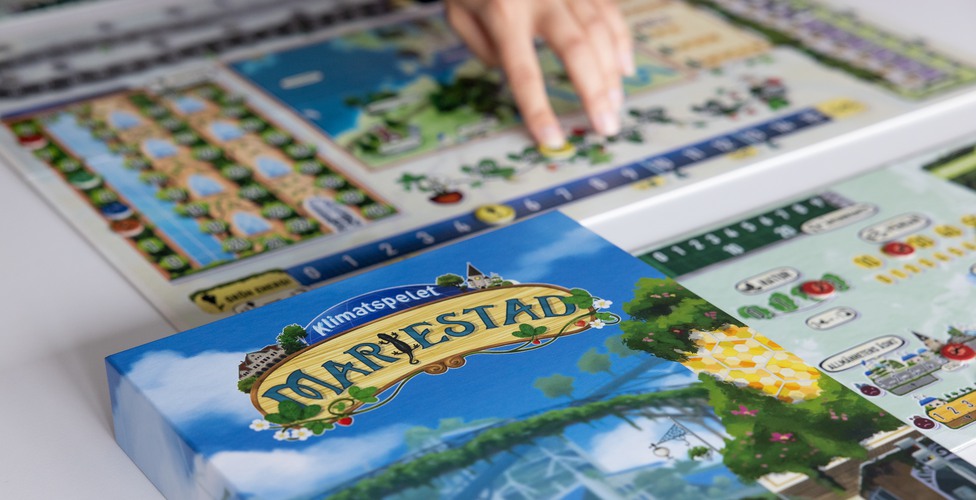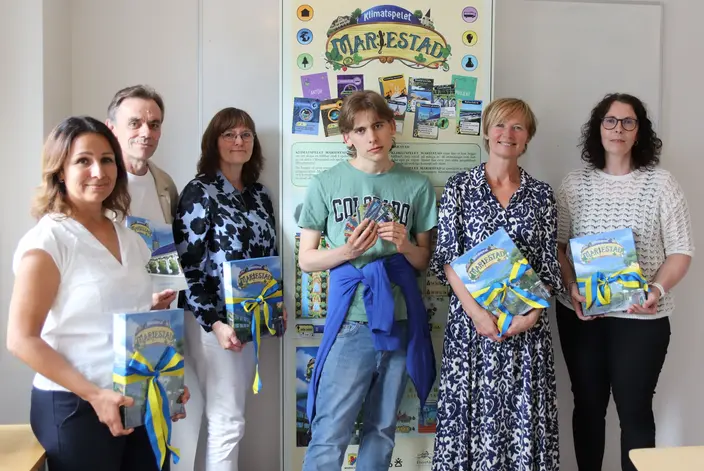Mariestad Climate Game
Eurogame style board game about city planning and sustainability
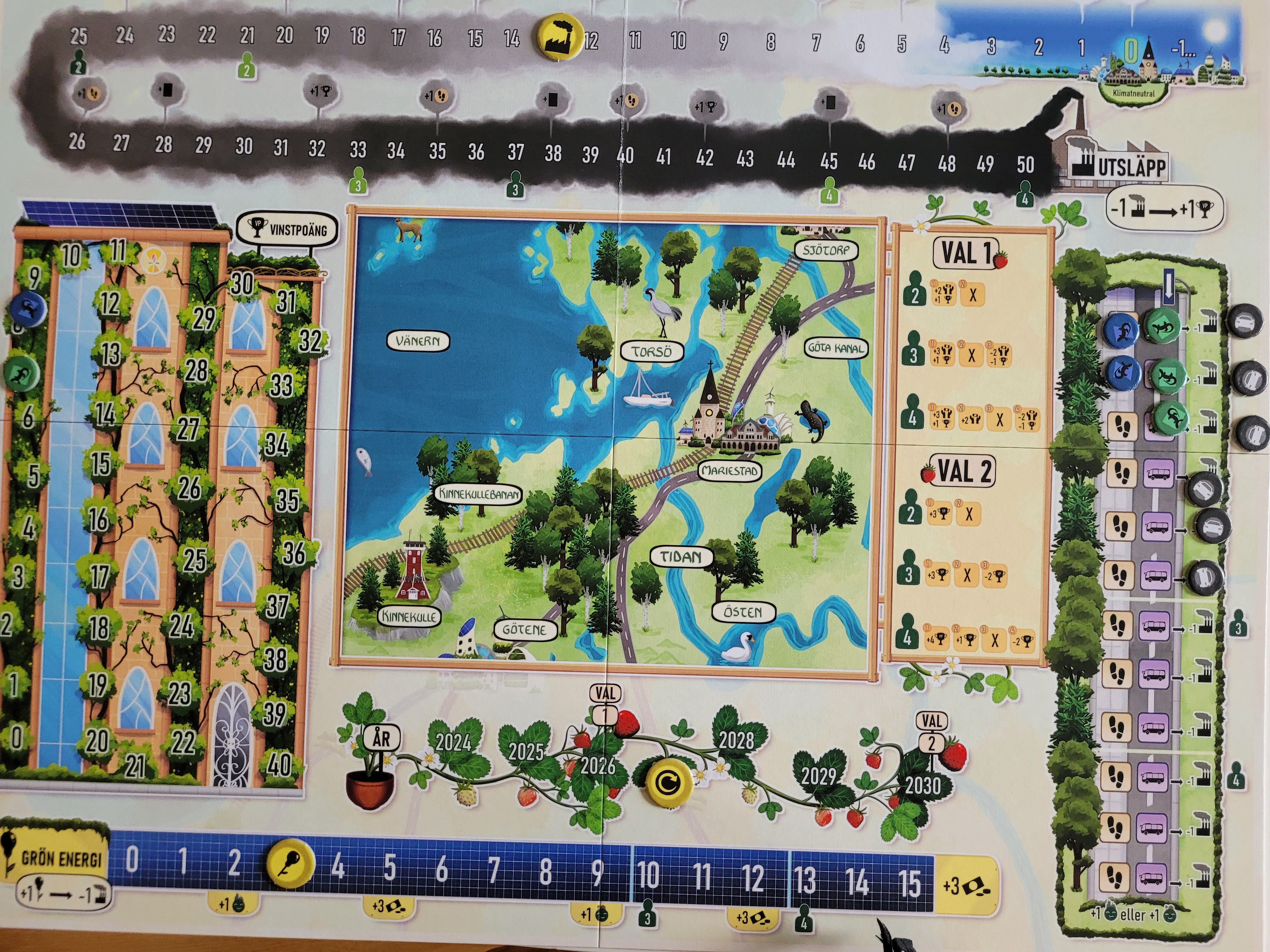
Photo of the game board in play with tokens on it
Link to the municiaplity article about the game Municipality Introduction Video of the game
I designed a board game for the municipality of Mariestad with graphics by Iris Casado, Wu Deyu, Alexander Ros and others.
The game is a eurogame inspired by games like Terraforming Mars however the game is designed to be fairly short and easy to learn.
The game can be played with 2-4 players and its playtime varies on the amount of players.
2 experienced players can play it in under 25 minutes, but for 4 new players can take about hour and half.
The goal of the game is to have the most Victory Points (VP) at the end of the game, in 2030.
The main way to get VP is by reducing pollution which can be done in a variety of different ways. Some of those ways include, producing renewable power, reducing car traffic and building green areas to absorb CO². During the game players take the role of an actor in the city, like a company or organization.
They then play different project cards, while managing their economy and relations with the people of the municipality.
The game takes place over 7 years, as part of the Viable Cities climate neutral 2030 strategy.
At the end of the 7 years the player player with the most Victory Points wins and hopefully Mariestad is Climate neutral.
The game is now printed and can be be played in Mariestad and at Högskolan i Skövde.
I have also done an online singleplayer version that can be played here
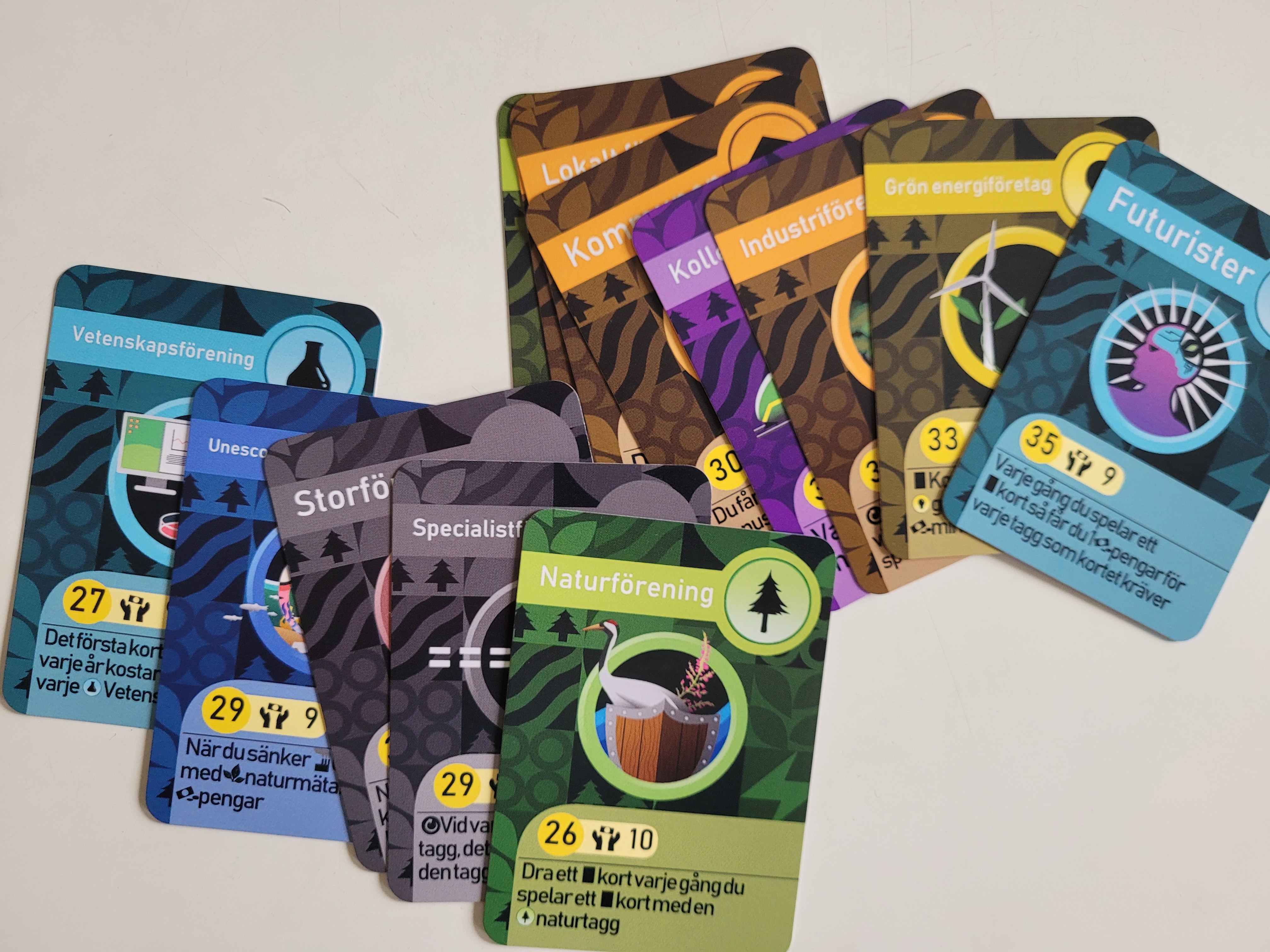
Actor Cards from the game
Things I've Worked on:
- Pitched the original idea to the municipality; a strategic board game about reducing pollution and building sustainably
- Worked on and tried out early concepts with Iris.
- Designed game mechanics and tested them
- Led many different test sessions with different groups, both skilled board game players and people not used to playing board games. Collected feedback from game tests
- Implemented feedback from test sessions. Worked iteratively on card and game balance.
- Talked with the people at Mariestad on how to best present different topics and themes.
- Helped Iris and Zoey with reference images and feedback for card illustrations and graphical design.
- Made a tool in Unity to compose the cards easier.
- Worked with the printing company (Spelkortsförlaget) to get the right outlines and margins for the cards and boards to print them.
- Made a digital solo version of the game to be playable online.
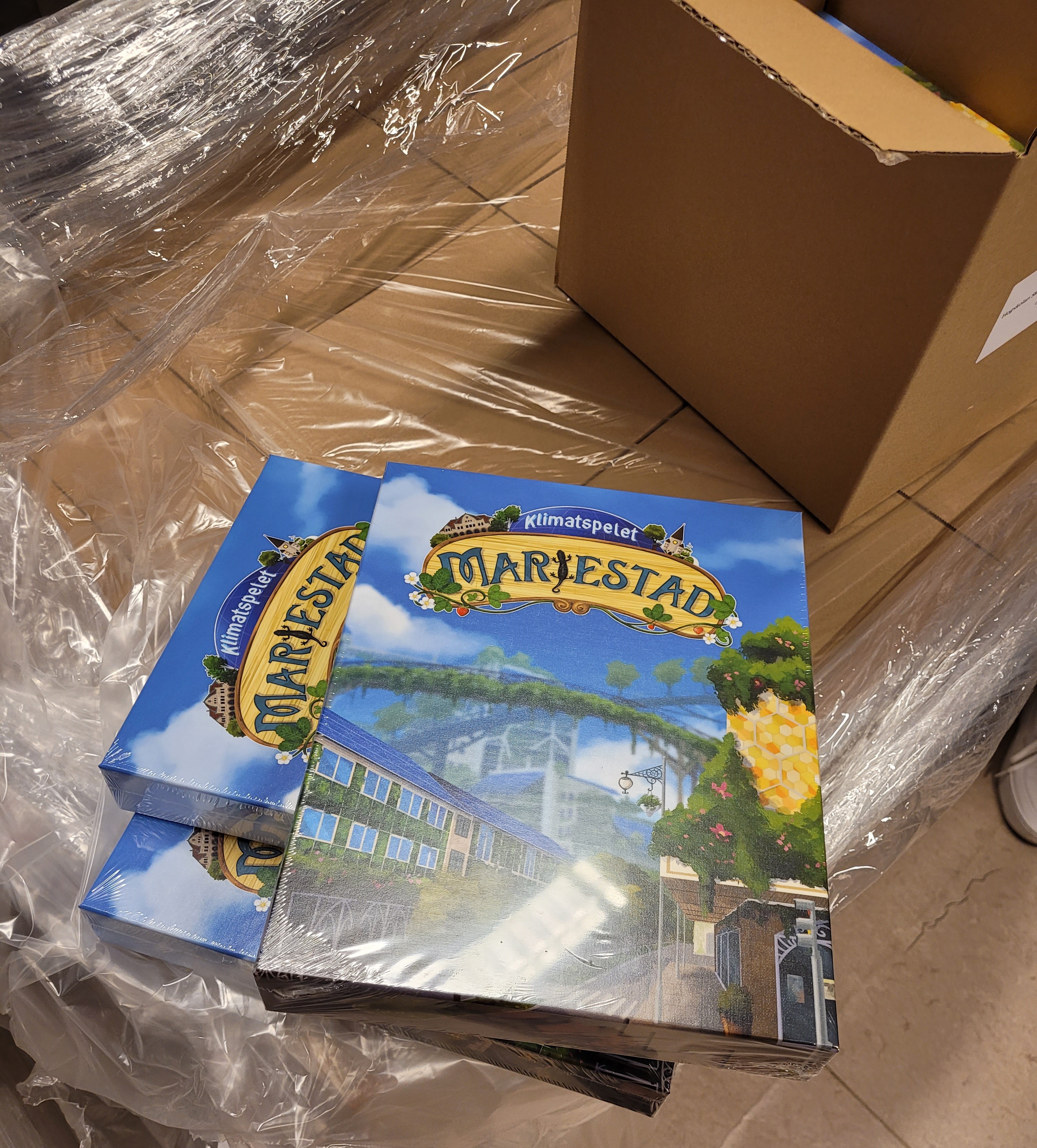
The project began when Mariestad looked for a project that related to their work on climate sustainability. I pitched the idea of a strategic board game and they liked the idea. At the start of the project it was me and Iris working on the project, with assistance from Lars Vipsjö at Högskolan i Skövde. We started with rough paper concepts and turned that into what you see now. During the project we invited Wu Deyu to help work on card illustrations and Alexander Ros to work on art for the actor cards. I also talked with some other students at Högskolan i Skövde who provided guest art on a few different cards.
I used the game as my artifact for my (1 year) master thesis on representation of technology and technological development in board games which can be found here. (Its in English)
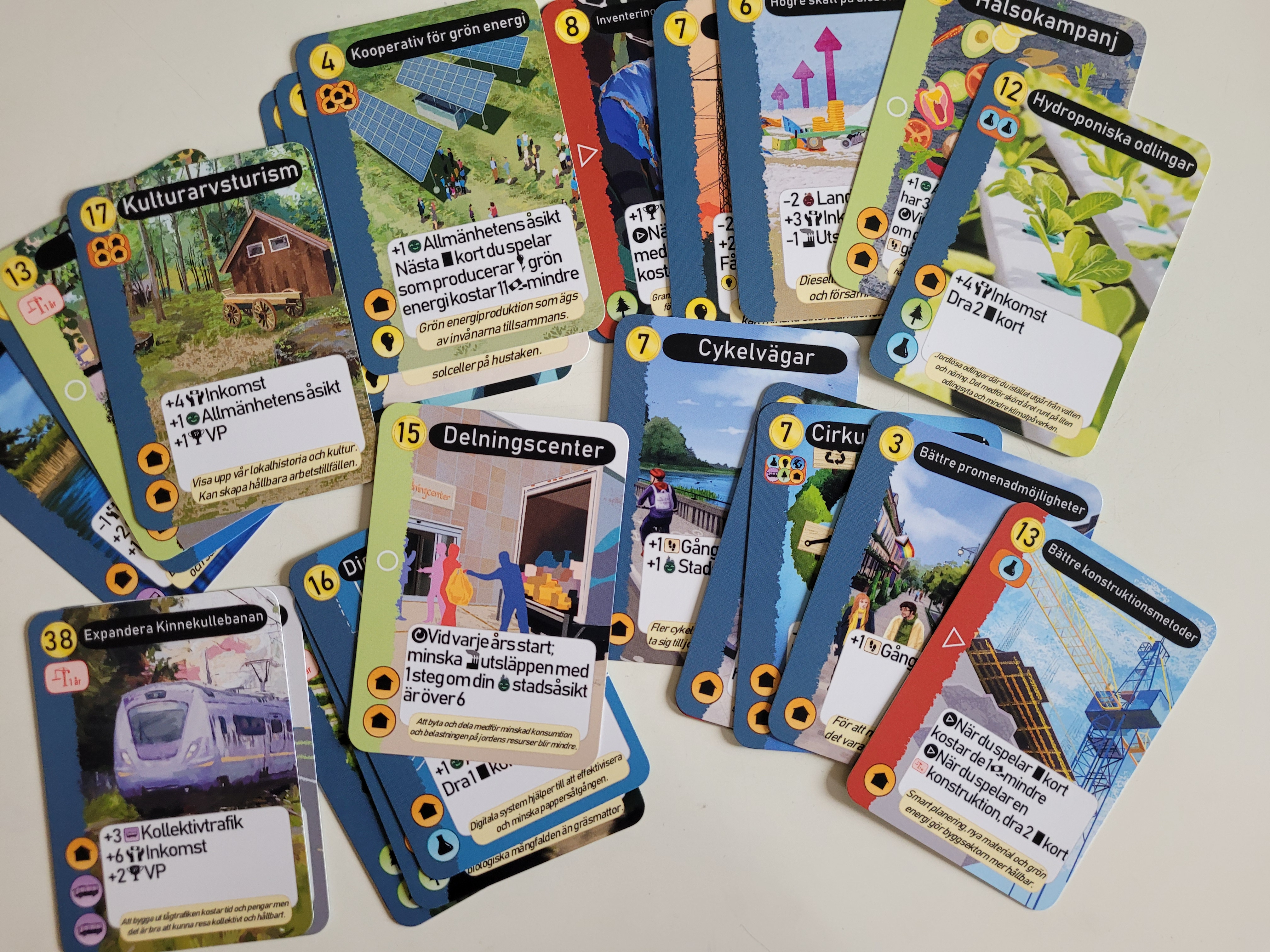
The core part of the game is the project cards. While there are standard actions that can always be undertaken, playing project cards is vital to winning the game.
There are 106 project cards in the game with differing effects, costs and requirements. At the start of the game each player draws 4 projects cards. Players get 2 more card draws each year and can draw new card from card effects and synergies. Players can also sell to for money per card or trade in two cards for to draw a new card. These effects help mitigate the effect of random card draws and provide interesting decisions during play.
The games card based design allows it to highlight a variety of different concepts and ideas and increases the games replayability. Personally I love designing new cards for games, to try to find ways to model different concepts and ideas with the games core mechanics. At one point there were 150 cards in the game, but we had to cut some so that we would have time get illustrations for all of them.
Screenshot from our cards spreadsheet. The columns seen are; Name, Price, Requirements, Border, Tags (1-3), Construction, Effect, Flavor text, Version and Image Inspiration. Each row is a different card. We used different color codes to mark which cards had complete illustrations, new changes and other things that came up.
Design Process
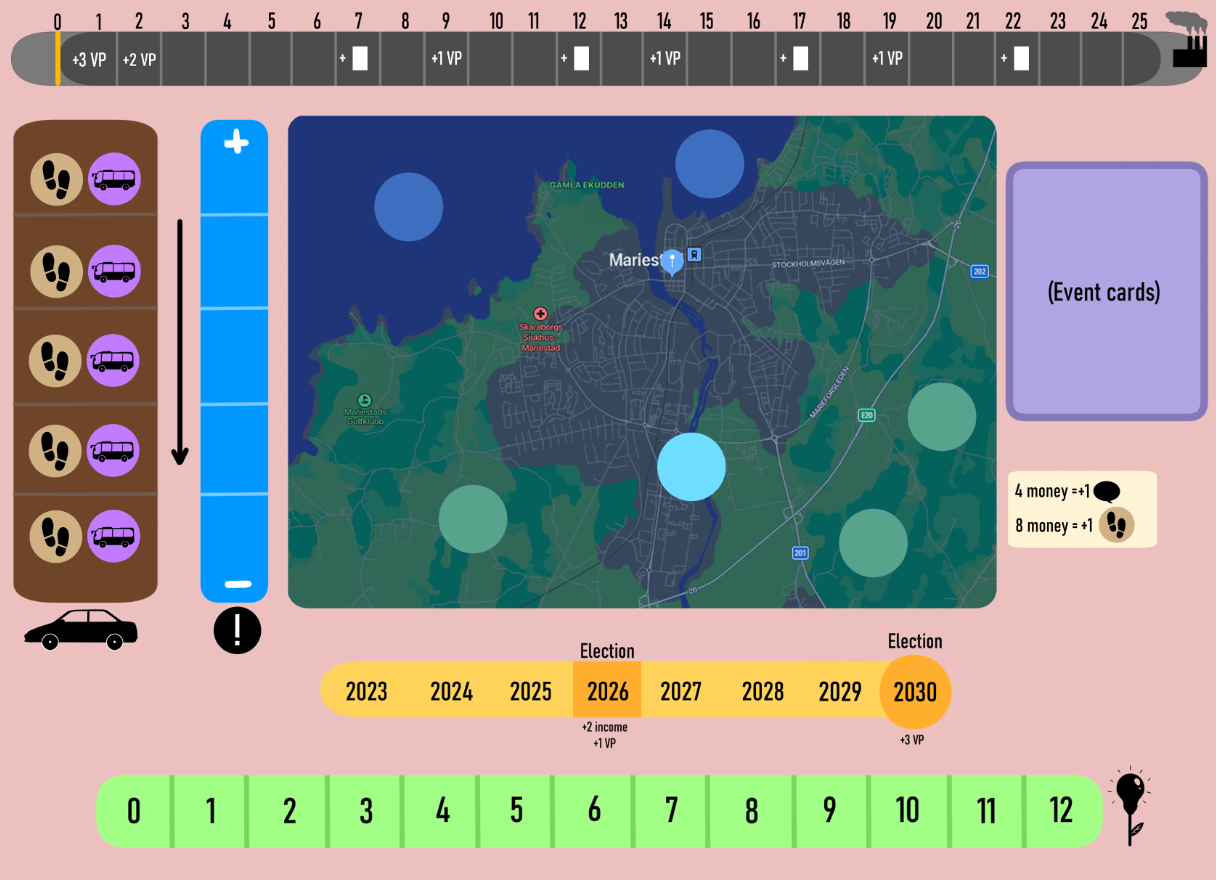
The first printed version of the game board
When I started designing the game we looked at what mechanics would fit and how to implement them. I took a lot of inspiration from one of my favorite board games, Terraforming Mars, but I wanted a shorter experience that's easier to learn, for players new(er) to board games.
The first printed version of the board can be seen on the left. It had the pollution track, the traffic meter and green energy track we have today, but we also had an awareness meter and an event deck. The (blue) awareness track was represented how aware and involved the inhabitants were regarding the climate issues. Players could raise awareness by playing certain cards and some cards needed an high awareness to be played or had other interactions with it. We ultimately chose to focus on other mechanics, but awareness or a something could still be a good mechanic in an hypothetical expansion or in a similar game. For example an Awareness mechanic could work well with cards relating to protests and activism, something our game currently doesn't really portray.
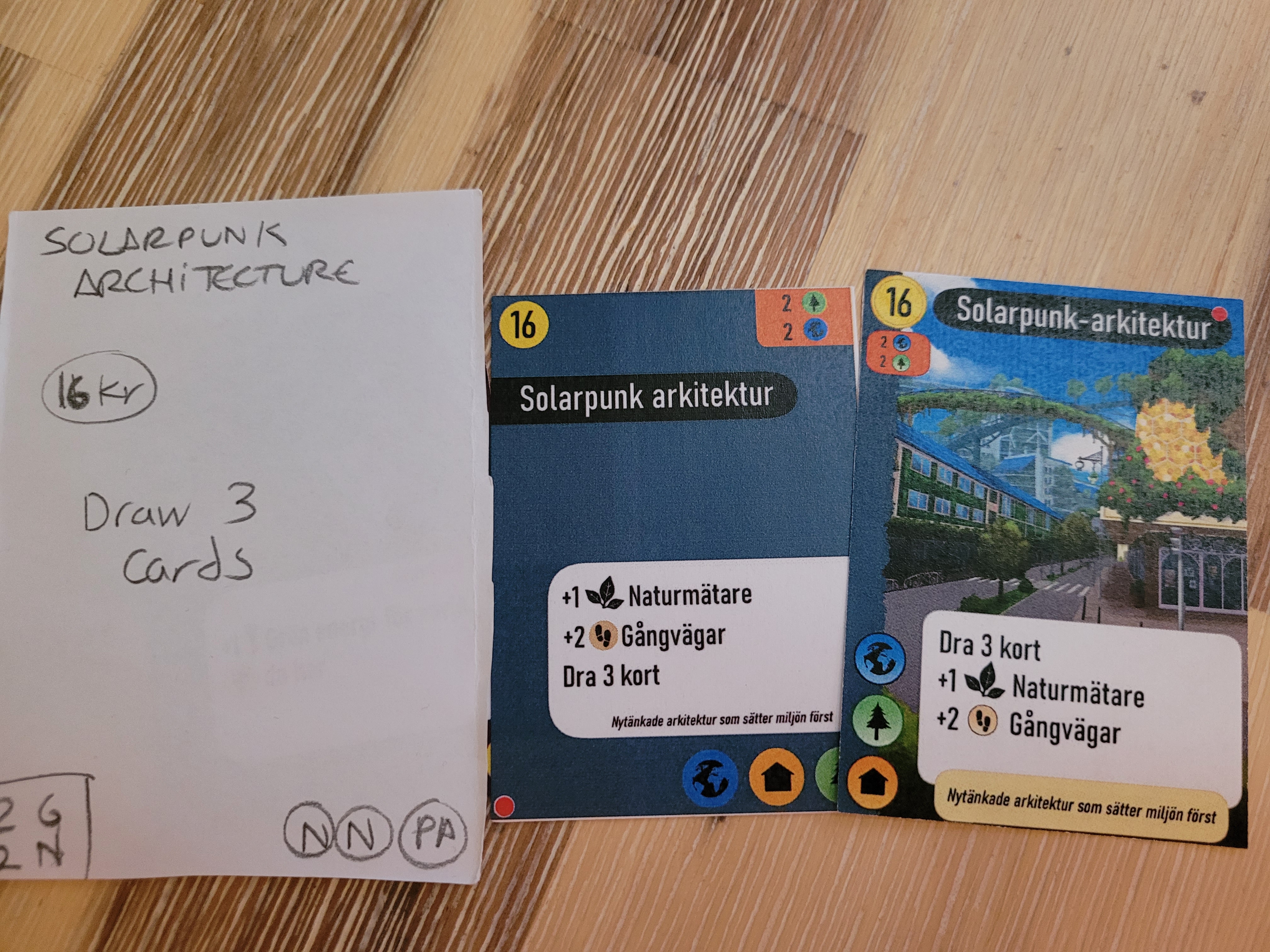
Evolution of a card's design and layout during development.
While events and awareness were mechanics we tried and later removed, the core of the game has still remained similar to the start. The layout of the cards still has mostly the same parts, even if they have moved around a lot. The first cards were made by hand to test out game mechanics. When we started making cards digitally we tried different layouts and aesthetics. A lot of this work was done by Iris, as I was working on game mechanics but we worked together as layout and mechanics do inevitably intersect.
One changed we made from the first prototypes were removing effects inherent in tags. At the start, a few tags had effects built into them. When playing a card with a nature tag you would increase your nature track. When playing a card with a path tag you would build a path and so on. At the same time, other tags like global had no inherent effect and were just for synergies. This was unclear to players and also limited us as we wanted cards to have at most 3 tags each. Now all of the effects cards have are written out in effect box and tags are just used for synergies and requirements. We have also done some other improvements like putting the cards requirements next to its price and giving flavor texts their own box, so they don't take up space on the card effect box.
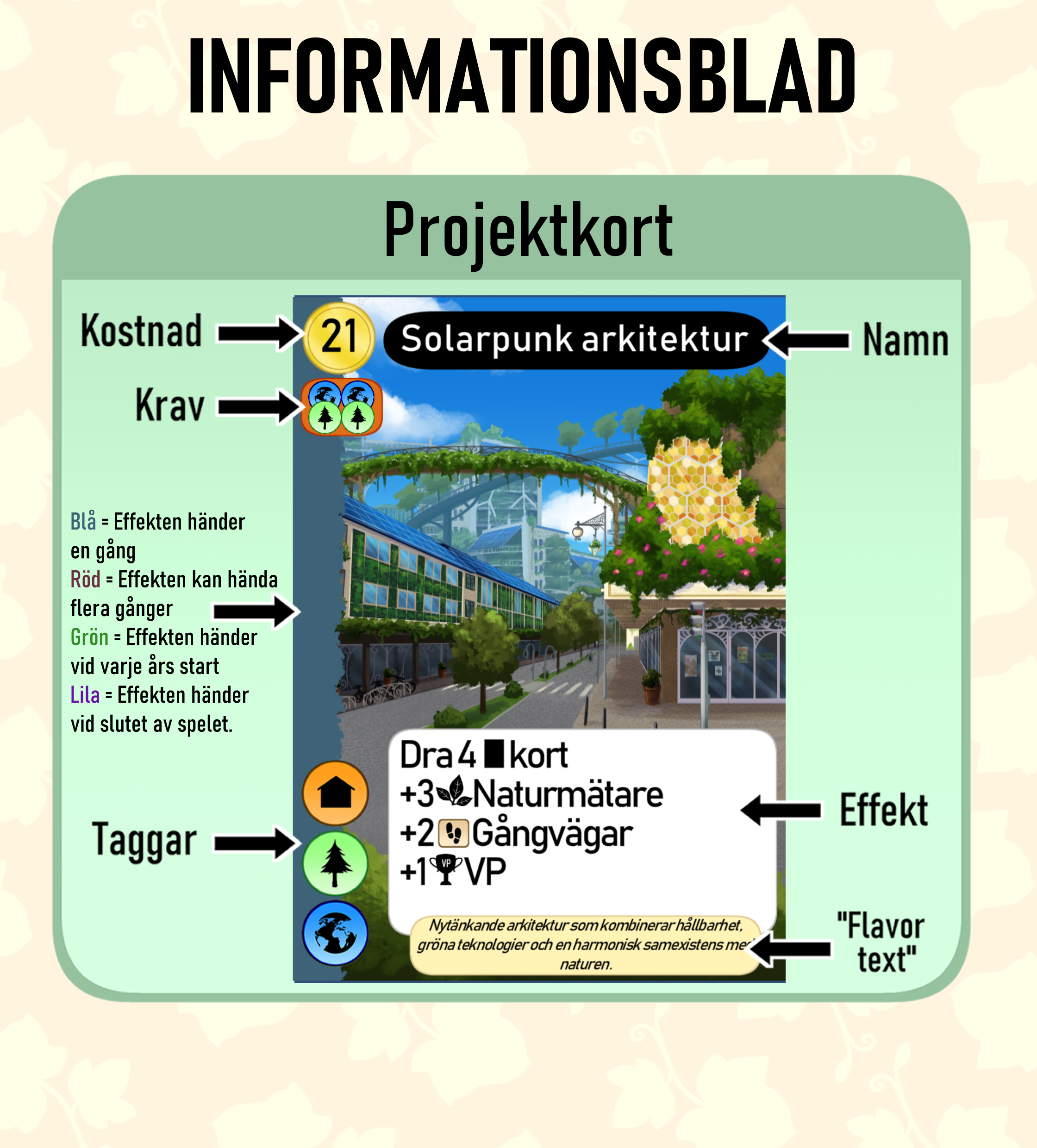
When it comes to coming up with the actual cards themselves, that was pretty easy. Its not hard to find potential ideas to help solve/mitigate climate issues and then turning them into cards is fun. Back in October of 2022 we already had 98 cards and a large of majority of them are still in the game today. Some cards have been removed, others renamed and many balance changes have been done. When it comes to inspiration for the cards I would like to thank the YouTube channel Undecided with Matt Ferrell and Wikipedia's Climate Change Mitigation page. They were great for finding inspiration and good jumping off points to start learning about related topics. The municipality of Mariestad has come with some suggestions for cards and feedback on my ideas, but it has also been an exchange of ideas both ways, with the game design process sending ideas them too.
Fall 2023 Playtesting
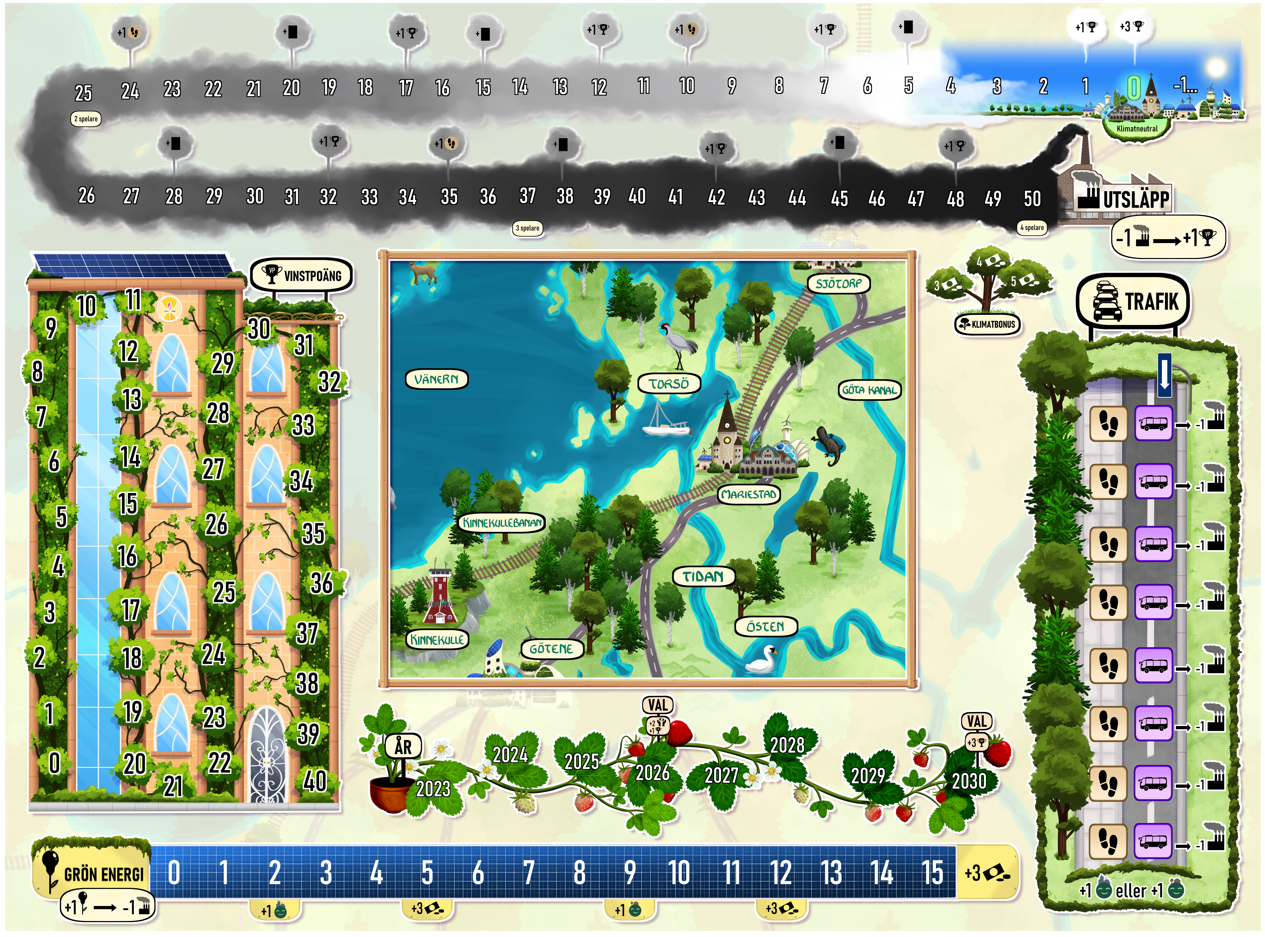
During the fall of 2023 I continually tested the game, primary working on balance, clarity and replayability.
Previous playtesting had largely been done in two ways; either me and Iris playing against each other with occasional guests joining in or at larger playtesting events at Mariestad or some other climate related event/actor.
The larger playtests generally involved people with limited experience with board games and sometimes with a limited time to play and finish a game.
This meant that while we knew the game was pretty well balanced for two players we had little information on other player counts.
I also wanted more players that could play multiple times and develop strategies and heuristics about the game.
So during the fall of 2023, I spent a lot of time playtesting and iterating upon feedback from playtests.
← The image on the left shows the board before the testing
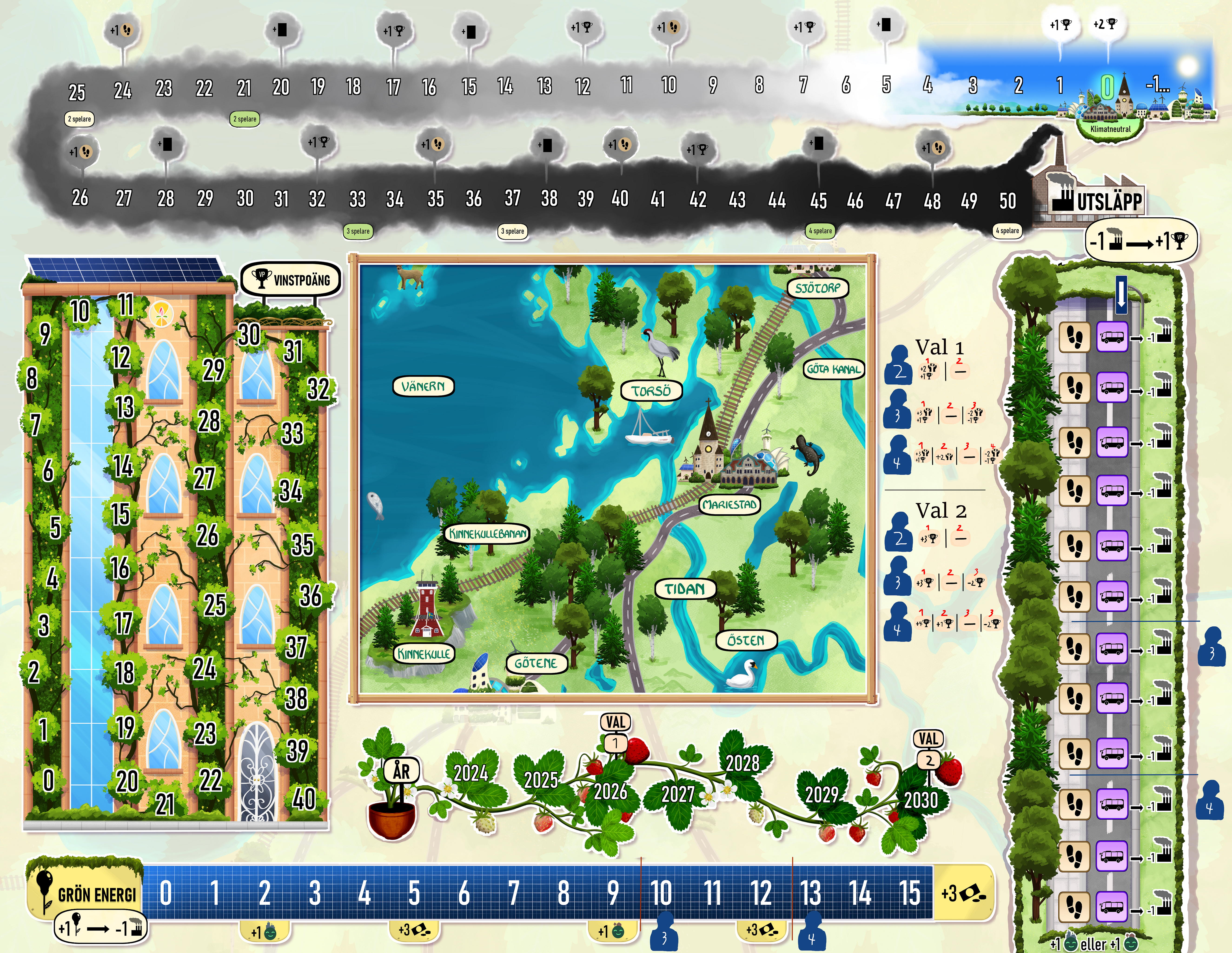
Most of the playtesting was done at AGES/Sugs, a board game club in Skövde.
I especially want to thank Alexander Ros who attended most of the playtests and made some actor tier-lists (and later some art too).
It was nice to see other peoples design thoughts on the balance of game and how it shifted as I continued to adjust cards.
The cards and actors aren't perfectly balanced and I doubt they ever will, but many "broken" combos are now gone and other cards that previously were bad were made stronger.
A lot of cards have also been clarified and small elements that were confusing, have either been changed or removed.
The image on the right shows the board at end of the playtesting →
The biggest changes from the testing however was to the board. The earliest version of the game board (one of them can be seen by scrolling up) had no way of scaling for player count. Some of the first playtests showed that we had to scale the pollution track to keep the challenge of becoming climate neutral, scaling it by 12.5 steps for every player (2 players start at 25, 3 at 37 and 4 at 50). For a while this worked pretty well. The traffic was most of the times reduced to zero before 2030 and that felt a bit unrealistic but otherwise everything worked well.
When I started playtesting with four experienced board gamers we started to see some interesting things however. The traffic meter often filled up halfway into the game. Now we had a bonus reward prepared for this, if a player builds busses and the traffic meter is full for example, any excess produced will instead reward them with an positive opinion. This worked well in more casual groups, but it meant that for experience groups, cards that built public transport effectively gave them positive opinion instead. And considering that if you have maxed out your positive opinion you instead got to draw a card, that created what we in playtesting referred to as a "draw machine". Being able to pay 8 (or with one card, 4) money to draw a card as many times as you wanted removed the card scarcity from the game.
It wasn't an intended strategy.
And while it very fun the first few times you get it to work, it gets stale and feels like a strange dominant strategy.
So to what did I do to fix this? Well I didn't remove it, not fully.
First off all I increased the amount of traffic steps from 8 to 12, and made it scale depending on the amount of players in the game.
This meant that the traffic meter wont generally get filled halfway trough most 4 player game and delays the formation of any draw engines.
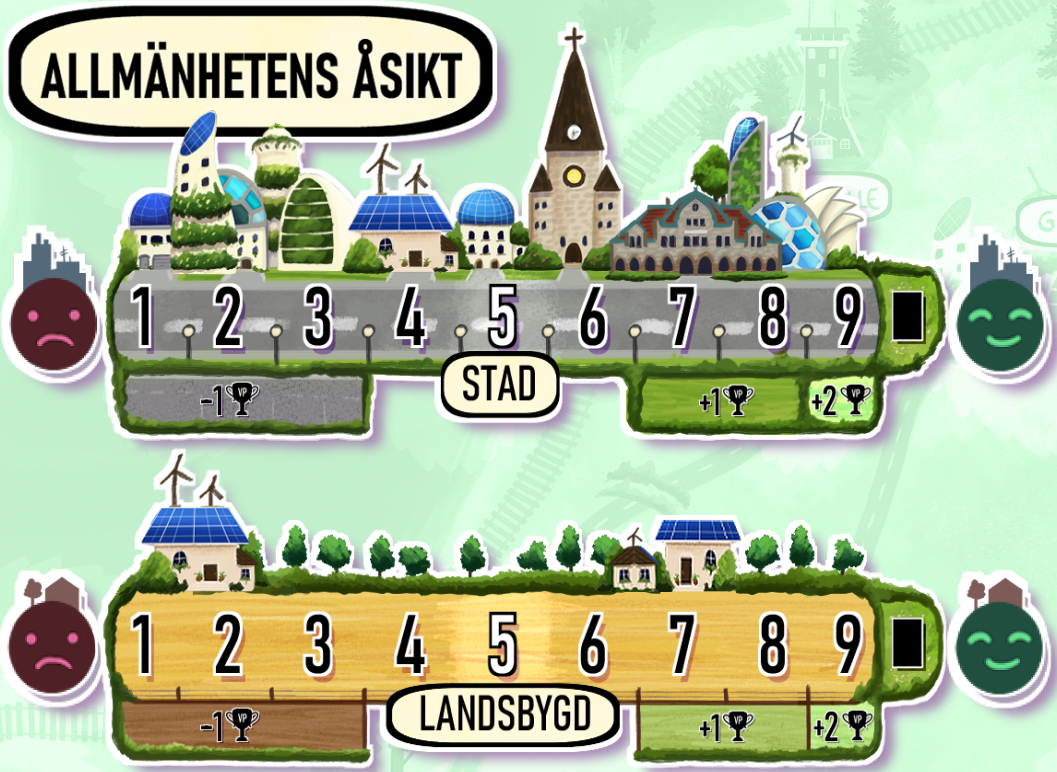
This is the opinion track on the player boards, where the opinion of the city and rural people towards the player actor is tracked. The opinion tracks start at 5 and give VP (victory points) at the end of the game.
Public opinion is also important for the elections which happen at the end of the year 2026 and at the end of the game. Previously the player who won these got some VP and income. This did however create the problem with that only winning mattered and players with low amounts of opinion saw little point in trying to compete. By changing it so the election rewards scale depending on the amount of players, players have a reason to fight for 2nd or 3rd place. Losing an election in 3 or 4 player games causes players to lose VP/Income, meaning that players should always be incentivized to compete in elections.
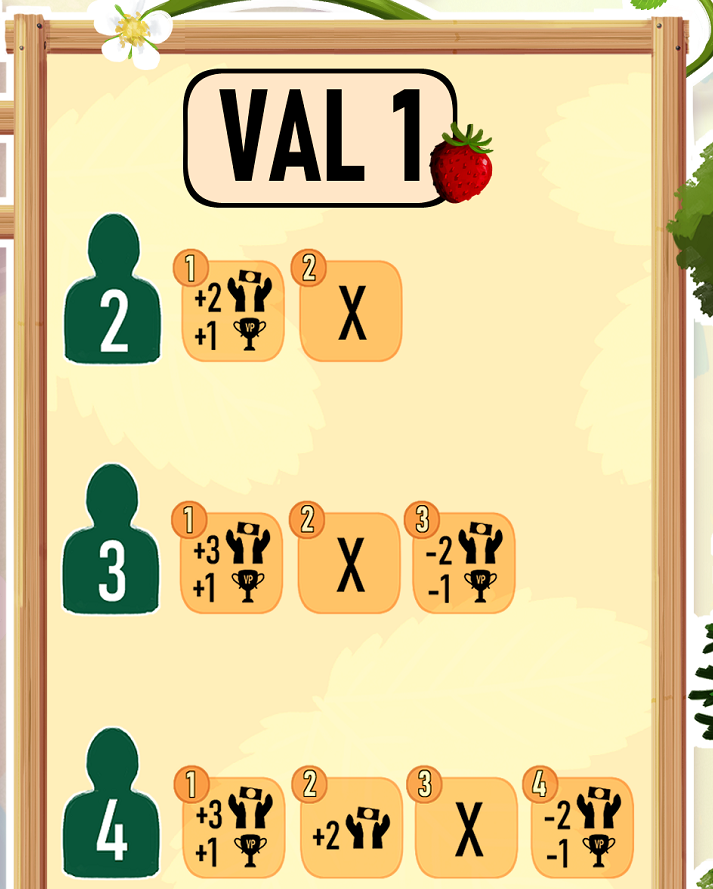
If a player gets their opinion above 9 they get to draw a card instead, which was part of creating the "draw machine" seen above. To try to fix this I experimented with trying to limit the reward. One idea was to limit to once per year. But that was hard to track and display on the player board. Another idea I had to fix it and add some more player interactivity to the game would be to add what I was calling a "citizens idea" row. This would be a row of around 3 project cards that would refresh each year. When a player got above 9 opinion on a track they would get to pick one of these cards. As there are only three, it would create an incentive to "race" for the cards and limit players from drawing too many each year
There could then also be "big business action" to buy one of those cards for 8 or even 10 money. Drawing a card is almost never worth 10 money, but sometimes there are specific cards you really want and using it could also deny an opponent from getting it.
Ultimately we found that adding it would add to much complexity for casual players and that with the other changes to game length and the size of the traffic meter it wasn't necessary. It could have been a possible variant for the game, but that would require more playtesting and possibly more components.
Card Making Tool
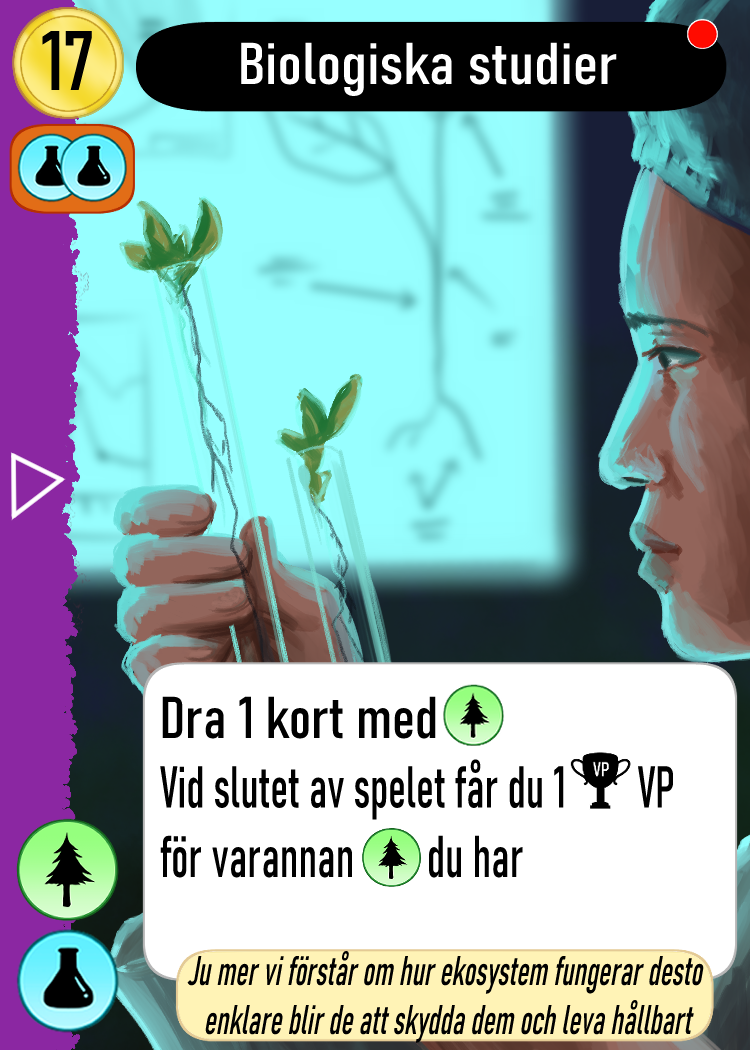
We started the project with hand written paper prototypes to test the concept. After seeing that they worked well, Iris started experimenting with card layouts in Clip Studio Paint, which she then could add card stats into and save for printing. After a while I took over editing the cards themself in Clip Studio Paint. This took some time and meant that if I wanted to change something on all cards, even minor details, I had to open them individually and change it. That wasn't very efficient and I felt like there should be a better solution
I had previous experience trying to use dedicated "card making tools" like nanDeck without much success, but I still tried again. But both nanDeck and another alternative I found online; Cider had unclear UI and complex scripting languages. I did find a tool called Paperrize, which I actually liked the UI and ease of use of, but it did not have support for Inline images in texts yet, so it didn't fit this task. So after nearly giving up I instead went, "well I guess I'll just make it myself".
So I made a "program" for it. I first tried to make it in Godot, as I wanted to learn to use it, but decided to stick to Unity as I knew it well and Godot had no built in way to automatically scale font size. And well, it was a success. I made a scriptable object for project cards and a script that puts the cards together from all of their components and then takes a screenshot. Now to edit cards I simply change the values of the scriptable object for the card. With that working I did the same thing for actor cards. I looked into trying to use this custom unity package so I could automatically import changes from the google spreadsheet, but it didn't fit how I had organized the cards so I decided not to.
To handle the symbols in texts I use Unity's TextMeshPro style sheet, with a function I made that automatically adds them in when it sees specific words in the a string that it takes in the effect text in this case. Today I've learned how to use CSV files to import data from spreadsheets and use that to import data like this. In my current projects I use that to import data from spreadsheets to Unity, but I haven't yet updated this tool to use that.
